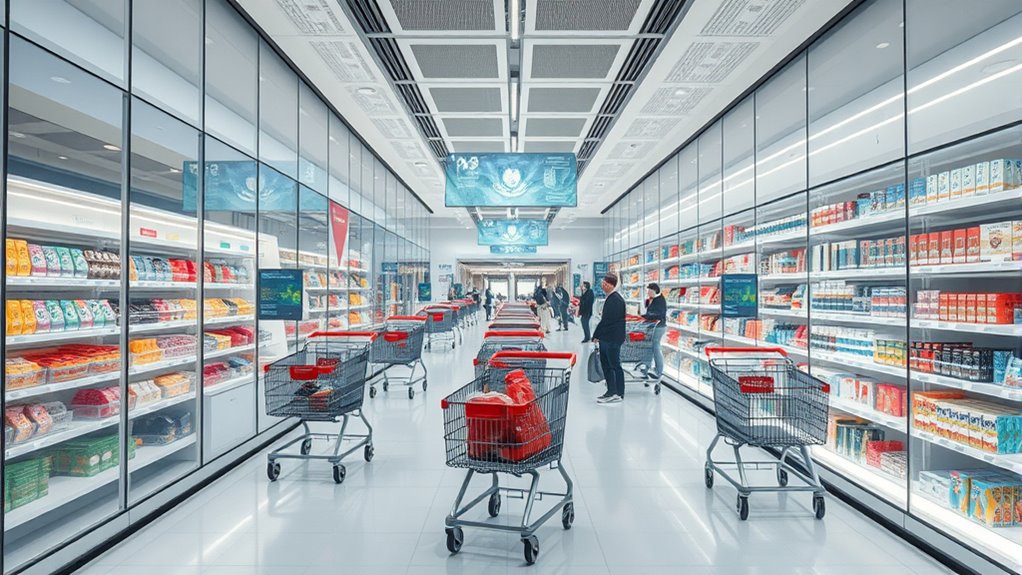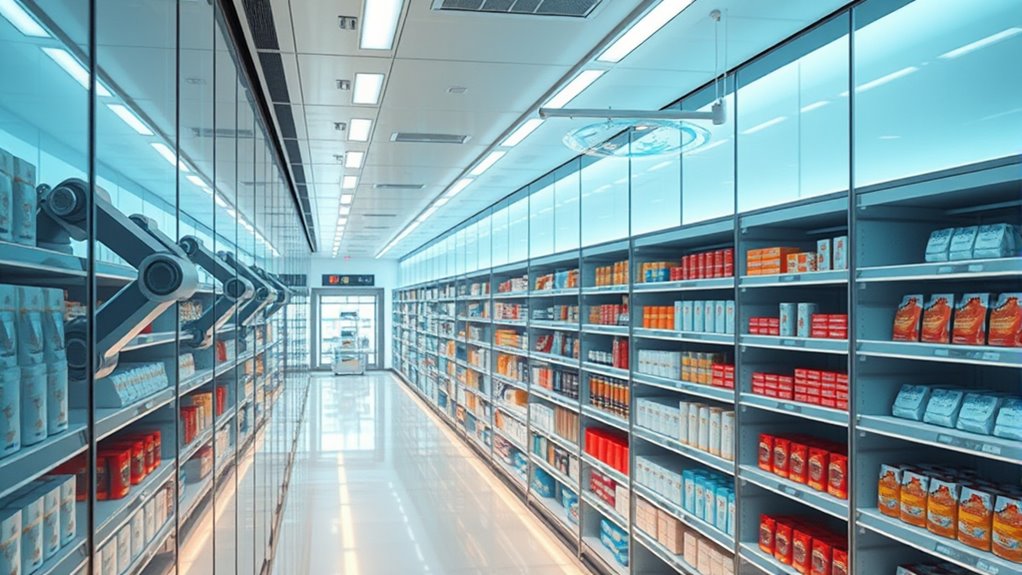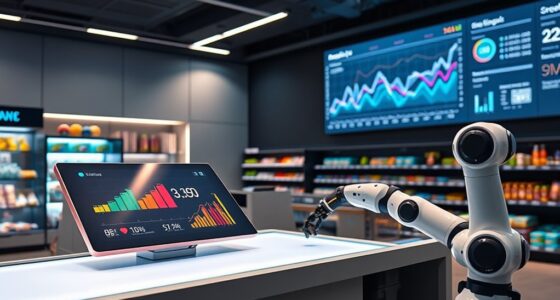Inside fully automated stores of the post-labor future, you’ll experience a seamless shopping journey powered by robots, AI, and IoT devices. There are no cashiers or staff—you just pick your items, and smart systems handle stocking, cleaning, and checkout automatically. Payments are contactless, and personalized suggestions make your visit faster and more convenient. If you want to explore how these innovative stores operate and what’s next, there’s more to discover below.
Key Takeaways
- Fully automated stores operate without staff, managed by robots and AI for stocking, cleaning, and food prep.
- Customers experience seamless shopping with contactless payments, AI personalization, and fast self-checkouts.
- Inventory and maintenance are continuously monitored and replenished automatically, reducing waste and stockouts.
- Advanced IoT and robotics enable quick adaptation to consumer preferences and optimize operational efficiency.
- Resilient backup power systems ensure uninterrupted operation, supporting a resilient, fast, and safe shopping environment.

As technology advances, fully automated stores are transforming the retail landscape, offering a glimpse into a post-labor future where machines handle most tasks. You step into these stores and immediately notice the absence of traditional cashiers or staff. Instead, robots and AI systems manage everything from cleaning and stocking to food preparation. These stores operate seamlessly, thanks to sophisticated integration of IoT devices, AI, and robotics, ensuring inventory is replenished and store conditions are maintained without human intervention. These innovations are supported by reliable whole-home backup power, which ensures continuous operation even during power outages, highlighting the importance of resilient infrastructure in automated environments. The market for robotic convenience stores is booming, projected to reach USD 3.11 trillion by 2030, with a steady growth rate of over 5% annually. Meanwhile, the broader retail automation market is expected to grow from USD 27.2 billion in 2024 to over USD 74 billion by 2035, driven by urbanization and consumer demand for faster, contactless shopping experiences. North America currently leads the way, with a significant share of the market due to its advanced technological infrastructure and high acceptance of automation. Robots in these stores handle up to 70% of daily tasks, reducing operational costs and increasing efficiency. The integration of autonomous delivery vehicles is also expanding, further streamlining the entire shopping process. As a shopper, you benefit from this automation through faster transactions, often using mobile points-of-sale or self-checkout systems that cut wait times. AI-driven personalization enhances your shopping experience by offering tailored product recommendations and support via chatbots or visual search tools. The rise of contactless payments, accelerated by safety concerns during the pandemic, further streamlines your interactions, making the shopping process safer and more frictionless. The automation doesn’t just improve convenience; it also boosts operational efficiency for retailers. By reducing reliance on manual labor, stores lower their costs and optimize inventory management, decreasing waste and stockouts. Advanced analytics provide insights into consumer behavior, allowing stores to adapt quickly to changing preferences. As these technologies continue evolving, regions like Asia-Pacific and Europe are increasing investments in retail robotics, promising a future where shopping becomes more integrated, personalized, and efficient. These innovations hint at a retail world where automation and AI are central, reshaping your shopping experience into something faster, safer, and more tailored than ever before.
Frequently Asked Questions
How Secure Are Fully Automated Stores From Cyberattacks?
Fully automated stores face significant cybersecurity risks, but their security depends on your measures. If you don’t use strong authentication, keep software updated, and train staff properly, you leave openings for attacks. AI-driven threats and supply chain vulnerabilities add to the danger. By implementing multi-factor authentication, securing cloud services, and using AI security tools, you can better protect your store from cyberattacks and minimize potential damages.
What Measures Protect Customer Privacy in Automated Shopping Environments?
You’re protected through strict adherence to data privacy laws like GDPR and CCPA, which require transparency and customer control. Automated stores implement data minimization, masking, and pseudonymization to limit sensitive info exposure. Secure systems encrypt customer data and use AI-driven security to detect breaches early. Plus, clear privacy policies and easy opt-out options build your trust, ensuring your personal info stays safe and under your control during your shopping experience.
How Do Automated Stores Handle Stock Replenishment and Inventory Management?
You know what they say, “a stitch in time saves nine.” Automated stores handle stock replenishment and inventory management by using real-time tracking with RFID tags, IoT devices, and sophisticated software like OMS and ERP systems. These tools automatically update stock levels, trigger reorders based on predefined rules, and coordinate across channels. AI-driven demand forecasting helps you anticipate needs, reducing overstock and stockouts, ensuring your shelves stay stocked efficiently.
Are There Accessibility Options for Differently-Abled Shoppers?
Yes, accessible options are integrated into automated stores. You’ll find wider aisles, clear signage, and adjustable-height kiosks designed for all mobility levels. Virtual assistants use voice commands to guide you, and digital interfaces are compatible with screen readers and keyboard navigation. Additionally, emergency exits are clearly marked, and product displays are within reach. These features guarantee you can shop independently, comfortably, and safely, regardless of your abilities.
What Are the Environmental Impacts of Fully Automated Retail Systems?
You see a store humming with energy-efficient lights and smart systems, reducing carbon footprints. Fully automated retail systems lower emissions through optimized logistics, real-time inventory, and localized fulfillment. However, the increased infrastructure and digital energy demands pose challenges. While they cut waste and transportation emissions, the initial energy use and electronic waste could offset gains. Overall, these systems balance environmental benefits with new sustainability challenges.
Conclusion
As we look toward a future where automation gently guides daily life, it’s worth considering how these silent changes might reshape our routines. While the promise of effortless convenience beckons, it also invites us to reflect on what we might gain or lose in the process. Embracing this new landscape with curiosity and care guarantees that, amid the quiet progress, we remain connected to the human touch that truly enriches our shared experience.








